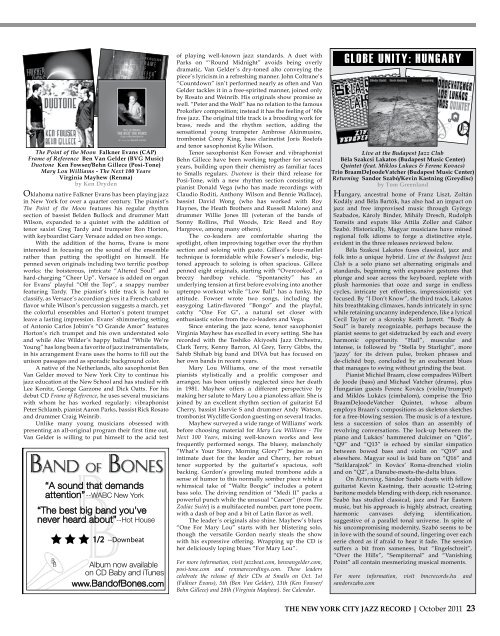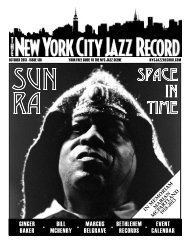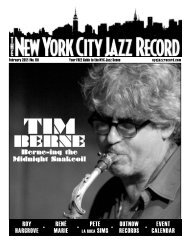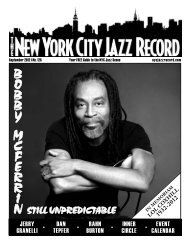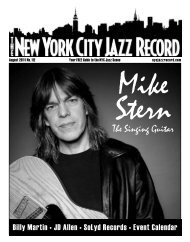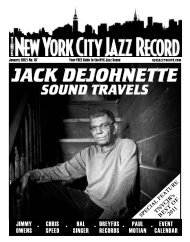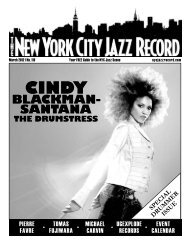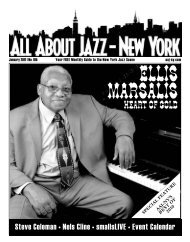Return of the Guitar Man - The New York City Jazz Record
Return of the Guitar Man - The New York City Jazz Record
Return of the Guitar Man - The New York City Jazz Record
Create successful ePaper yourself
Turn your PDF publications into a flip-book with our unique Google optimized e-Paper software.
<strong>The</strong> Point <strong>of</strong> <strong>the</strong> Moon Falkner Evans (CAP)<br />
Frame <strong>of</strong> Reference Ben Van Gelder (BVG Music)<br />
Duotone Ken Fowser/Behn Gillece (Posi-Tone)<br />
Mary Lou Williams - <strong>The</strong> Next 100 Years<br />
Virginia Mayhew (Renma)<br />
by Ken Dryden<br />
Oklahoma native Falkner Evans has been playing jazz<br />
in <strong>New</strong> <strong>York</strong> for over a quarter century. <strong>The</strong> pianist’s<br />
<strong>The</strong> Point <strong>of</strong> <strong>the</strong> Moon features his regular rhythm<br />
section <strong>of</strong> bassist Belden Bullock and drummer Matt<br />
Wilson, expanded to a quintet with <strong>the</strong> addition <strong>of</strong><br />
tenor saxist Greg Tardy and trumpeter Ron Horton,<br />
with keyboardist Gary Versace added on two songs.<br />
With <strong>the</strong> addition <strong>of</strong> <strong>the</strong> horns, Evans is more<br />
interested in focusing on <strong>the</strong> sound <strong>of</strong> <strong>the</strong> ensemble<br />
ra<strong>the</strong>r than putting <strong>the</strong> spotlight on himself. He<br />
penned seven originals including two terrific postbop<br />
works: <strong>the</strong> boisterous, intricate “Altered Soul” and<br />
hard-charging “Cheer Up”. Versace is added on organ<br />
for Evans’ playful “Off <strong>the</strong> Top”, a snappy number<br />
featuring Tardy. <strong>The</strong> pianist’s title track is hard to<br />
classify, as Versace’s accordion gives it a French cabaret<br />
flavor while Wilson’s percussion suggests a march, yet<br />
<strong>the</strong> colorful ensembles and Horton’s potent trumpet<br />
leave a lasting impression. Evans’ shimmering setting<br />
<strong>of</strong> Antonio Carlos Jobim’s “O Grande Amor” features<br />
Horton’s rich trumpet and his own understated solo<br />
and while Alec Wilder’s happy ballad “While We’re<br />
Young” has long been a favorite <strong>of</strong> jazz instrumentalists,<br />
in his arrangement Evans uses <strong>the</strong> horns to fill out <strong>the</strong><br />
unison passages and as sporadic background color.<br />
A native <strong>of</strong> <strong>the</strong> Ne<strong>the</strong>rlands, alto saxophonist Ben<br />
Van Gelder moved to <strong>New</strong> <strong>York</strong> <strong>City</strong> to continue his<br />
jazz education at <strong>the</strong> <strong>New</strong> School and has studied with<br />
Lee Konitz, George Garzone and Dick Oatts. For his<br />
debut CD Frame <strong>of</strong> Reference, he uses several musicians<br />
with whom he has worked regularly: vibraphonist<br />
Peter Schlamb, pianist Aaron Parks, bassist Rick Rosato<br />
and drummer Craig Weinrib.<br />
Unlike many young musicians obsessed with<br />
presenting an all-original program <strong>the</strong>ir first time out,<br />
Van Gelder is willing to put himself to <strong>the</strong> acid test<br />
<strong>of</strong> playing well-known jazz standards. A duet with<br />
Parks on “‘Round Midnight” avoids being overly<br />
dramatic, Van Gelder’s dry-toned alto conveying <strong>the</strong><br />
piece’s lyricism in a refreshing manner. John Coltrane’s<br />
“Countdown” isn’t performed nearly as <strong>of</strong>ten and Van<br />
Gelder tackles it in a free-spirited manner, joined only<br />
by Rosato and Weinrib. His originals show promise as<br />
well. “Peter and <strong>the</strong> Wolf” has no relation to <strong>the</strong> famous<br />
Prok<strong>of</strong>iev composition; instead it has <strong>the</strong> feeling <strong>of</strong> ‘60s<br />
free jazz. <strong>The</strong> original title track is a brooding work for<br />
brass, reeds and <strong>the</strong> rhythm section, adding <strong>the</strong><br />
sensational young trumpeter Ambrose Akinmusire,<br />
trombonist Corey King, bass clarinetist Joris Roel<strong>of</strong>s<br />
and tenor saxophonist Kylie Wilson.<br />
Tenor saxophonist Ken Fowser and vibraphonist<br />
Behn Gillece have been working toge<strong>the</strong>r for several<br />
years, building upon <strong>the</strong>ir chemistry as familiar faces<br />
to Smalls regulars. Duotone is <strong>the</strong>ir third release for<br />
Posi-Tone, with a new rhythm section consisting <strong>of</strong><br />
pianist Donald Vega (who has made recordings with<br />
Claudio Roditi, Anthony Wilson and Bennie Wallace),<br />
bassist David Wong (who has worked with Roy<br />
Haynes, <strong>the</strong> Heath Bro<strong>the</strong>rs and Russell Malone) and<br />
drummer Willie Jones III (veteran <strong>of</strong> <strong>the</strong> bands <strong>of</strong><br />
Sonny Rollins, Phil Woods, Eric Reed and Roy<br />
Hargrove, among many o<strong>the</strong>rs).<br />
<strong>The</strong> co-leaders are comfortable sharing <strong>the</strong><br />
spotlight, <strong>of</strong>ten improvising toge<strong>the</strong>r over <strong>the</strong> rhythm<br />
section and soloing with gusto. Gillece’s four-mallet<br />
technique is formidable while Fowser’s melodic, bigtoned<br />
approach to soloing is <strong>of</strong>ten spacious. Gillece<br />
penned eight originals, starting with “Overcooked”, a<br />
breezy hardbop vehicle. “Spontaneity” has an<br />
underlying tension at first before evolving into ano<strong>the</strong>r<br />
uptempo workout while “Low Ball” has a funky, hip<br />
attitude. Fowser wrote two songs, including <strong>the</strong><br />
easygoing Latin-flavored “Bongo” and <strong>the</strong> playful,<br />
catchy “One For G”, a natural set closer with<br />
enthusiastic solos from <strong>the</strong> co-leaders and Vega.<br />
Since entering <strong>the</strong> jazz scene, tenor saxophonist<br />
Virginia Mayhew has excelled in every setting. She has<br />
recorded with <strong>the</strong> Toshiko Akiyoshi <strong>Jazz</strong> Orchestra,<br />
Clark Terry, Kenny Barron, Al Grey, Terry Gibbs, <strong>the</strong><br />
Sahib Shihab big band and DIVA but has focused on<br />
her own bands in recent years.<br />
Mary Lou Williams, one <strong>of</strong> <strong>the</strong> most versatile<br />
pianists stylistically and a prolific composer and<br />
arranger, has been unjustly neglected since her death<br />
in 1981. Mayhew <strong>of</strong>fers a different perspective by<br />
making her salute to Mary Lou a pianoless affair. She is<br />
joined by an excellent rhythm section <strong>of</strong> guitarist Ed<br />
Cherry, bassist Harvie S and drummer Andy Watson,<br />
trombonist Wycliffe Gordon guesting on several tracks.<br />
Mayhew surveyed a wide range <strong>of</strong> Williams’ work<br />
before choosing material for Mary Lou Williams - <strong>The</strong><br />
Next 100 Years, mixing well-known works and less<br />
frequently performed songs. <strong>The</strong> bluesy, melancholy<br />
“What’s Your Story, Morning Glory?” begins as an<br />
intimate duet for <strong>the</strong> leader and Cherry, her robust<br />
tenor supported by <strong>the</strong> guitarist’s spacious, s<strong>of</strong>t<br />
backing. Gordon’s growling muted trombone adds a<br />
sense <strong>of</strong> humor to this normally somber piece while a<br />
whimsical take <strong>of</strong> “Waltz Boogie” includes a potent<br />
bass solo. <strong>The</strong> driving rendition <strong>of</strong> “Medi II” packs a<br />
powerful punch while <strong>the</strong> unusual “Cancer” (from <strong>The</strong><br />
Zodiac Suite) is a multifaceted number, part tone poem,<br />
with a dash <strong>of</strong> bop and a bit <strong>of</strong> Latin flavor as well.<br />
<strong>The</strong> leader’s originals also shine. Mayhew’s blues<br />
“One For Mary Lou” starts with her blistering solo,<br />
though <strong>the</strong> versatile Gordon nearly steals <strong>the</strong> show<br />
with his expressive <strong>of</strong>fering. Wrapping up <strong>the</strong> CD is<br />
her deliciously loping blues “For Mary Lou”.<br />
For more information, visit jazzbeat.com, benvangelder.com,<br />
posi-tone.com and renmarecordings.com. <strong>The</strong>se leaders<br />
celebrate <strong>the</strong> release <strong>of</strong> <strong>the</strong>ir CDs at Smalls on Oct. 1st<br />
(Falkner Evans), 5th (Ben Van Gelder), 13th (Ken Fowser/<br />
Behn Gillece) and 28th (Virginia Mayhew). See Calendar.<br />
GLOBE UNITY: HUNGARY<br />
Live at <strong>the</strong> Budapest <strong>Jazz</strong> Club<br />
Béla Szakcsi Lakatos (Budapest Music Center)<br />
Quintet (feat. Miklos Lukacs & Ferenc Kovacs)<br />
Trio BraamDeJoodeVatcher (Budapest Music Center)<br />
<strong>Return</strong>ing Sandor Szabó/Kevin Kastning (Greydisc)<br />
by Tom Greenland<br />
Hungary, ancestral home <strong>of</strong> Franz Liszt, Zoltán<br />
Kodály and Béla Bartók, has also had an impact on<br />
jazz and free improvised music through György<br />
Szabados, Károly Binder, Mihály Dresch, Rudolph<br />
Tomsits and expats like Attila Zoller and Gábor<br />
Szabó. Historically, Magyar musicians have mined<br />
regional folk idioms to forge a distinctive style,<br />
evident in <strong>the</strong> three releases reviewed below.<br />
Béla Szakcsi Lakatos fuses classical, jazz and<br />
folk into a unique hybrid. Live at <strong>the</strong> Budapest <strong>Jazz</strong><br />
Club is a solo piano set alternating originals and<br />
standards, beginning with expansive gestures that<br />
plunge and soar across <strong>the</strong> keyboard, replete with<br />
plush harmonies that ooze and surge in endless<br />
cycles, intricate yet effortless, impressionistic yet<br />
focused. By “I Don’t Know”, <strong>the</strong> third track, Lakatos<br />
hits breathtaking climaxes, hands intricately in sync<br />
while retaining uncanny independence, like a lyrical<br />
Cecil Taylor or a skronky Keith Jarrett. “Body &<br />
Soul” is barely recognizable, perhaps because <strong>the</strong><br />
pianist seems to get sidetracked by each and every<br />
harmonic opportunity. “Hail”, muscular and<br />
intense, is followed by “Stella by Starlight”, more<br />
‘jazzy’ for its driven pulse, broken phrases and<br />
de-clichéd bop, concluded by an exuberant blues<br />
that manages to swing without grinding <strong>the</strong> beat.<br />
Pianist Michiel Braam, close compadres Wilbert<br />
de Joode (bass) and Michael Vatcher (drums), plus<br />
Hungarian guests Ferenc Kovács (violin/trumpet)<br />
and Miklós Lukács (cimbalom), comprise <strong>the</strong> Trio<br />
BraamDeJoodeVatcher Quintet, whose album<br />
employs Braam’s compositions as skeleton sketches<br />
for a free-blowing session. <strong>The</strong> music is <strong>of</strong> a texture,<br />
less a succession <strong>of</strong> solos than an assembly <strong>of</strong><br />
revolving conversations. <strong>The</strong> lock-up between <strong>the</strong><br />
piano and Lukács’ hammered dulcimer on “Q16”,<br />
“Q9” and “Q13” is echoed by similar simpatico<br />
between bowed bass and violin on “Q19” and<br />
elsewhere. Magyar soul is laid bare on “Q16” and<br />
“Sziklarajzok” in Kovács’ Roma-drenched violin<br />
and on “Q2”, a Danube-meets-<strong>the</strong>-delta blues.<br />
On <strong>Return</strong>ing, Sándor Szabó duets with fellow<br />
guitarist Kevin Kastning, <strong>the</strong>ir acoustic 12-string<br />
baritone models blending with deep, rich resonance.<br />
Szabó has studied classical, jazz and Far Eastern<br />
music, but his approach is highly abstract, creating<br />
harmonic canvases defying identification,<br />
suggestive <strong>of</strong> a parallel tonal universe. In spite <strong>of</strong><br />
his uncompromising modernity, Szabó seems to be<br />
in love with <strong>the</strong> sound <strong>of</strong> sound, lingering over each<br />
eerie chord as if afraid to hear it fade. <strong>The</strong> session<br />
suffers a bit from sameness, but “Engelschreit”,<br />
“Over <strong>the</strong> Hills”, “Sempiternal” and “Vanishing<br />
Point” all contain mesmerizing musical moments.<br />
For more information, visit bmcrecords.hu and<br />
sandorszabo.com<br />
THE NEW YORK CITY JAZZ RECORD | October 2011 23


